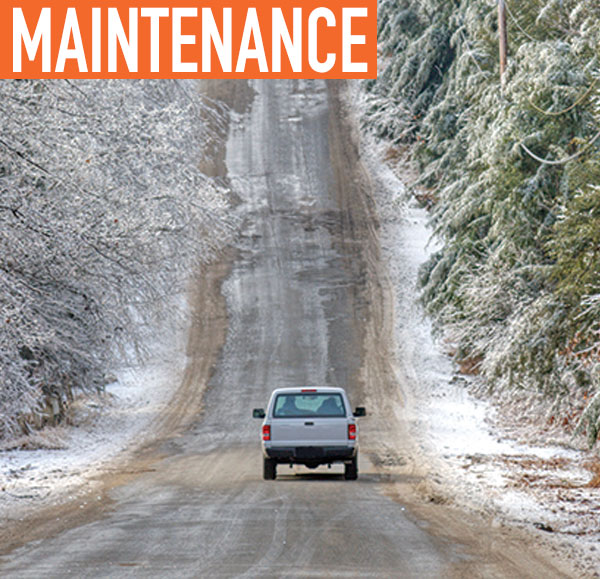Fleets and drivers should always have a good written maintenance policy in place. This policy should be specific to their vehicles, equipment, geography, distance they travel, loads they carry, time on the road, and other pertinent factors. Conditions for winter travel can obviously be more challenging, and safety is ultimately the number one priority. In general, the following checks should be performed by the driver prior to any trip:
- Driver inspection pre-trip
- Maintain proper tire pressure
- Monitor tread depths
- Watch for irregular wear
- Inspect suspension components
A pre-trip inspection is important in improving the operation’s safety and efficiency. A solid pre-trip inspection is critical to ensuring the best performance out of the trucks while staying safe. The advantages of a pre-trip inspection include improved highway safety, reduced downtime, increased productivity, and providing on-time load delivery.
TIRE PRESSURE REQUIREMENTS
Tire pressure monitoring is a key component of a complete tire maintenance program. The number of tire-related issues and roadside events will be significantly reduced by maintaining proper tire pressure inspections and, ultimately, downtime on the side of the road can be reduced.
With the onset of cold weather, tire pressures will drop. It is imperative to set the tire pressure prior to operating the vehicle at the onset of the trip, while the tires are at ambient temperature. The ideal time to check tire pressures is during the pre-trip inspection, prior to departure. Driving, even for a short distance, causes tires to heat up and pressure to increase.
Drivers should always use a properly calibrated gauge when verifying the pressure of a tire and should not rely on the aspect of the tire. If the tire is 20 percent below the recommended pressure, it must be considered flat. It should then be removed and inspected for punctures or other damage. Failure to do so may lead to unwanted downtime.
WINTER TREADS
Fleets and owner-operators know their specific operating and delivery conditions. If the fleet is located or operates in geographical locations likely to experience winter conditions (such as the Northeast, Northern Plains, Upper Midwest, Pacific Mountains, or Canada) they may want to consider a specific tire tread or a retread for those conditions.
Michelin offers specific products that perform very well in these conditions. The MICHELIN XDS2 tire is designed for year-round drive axle traction, but optimized for challenging, severe winter conditions via compound and tread design. The open shoulder, rugged, directional tread design helps boost snow and ice traction with Michelin Durable Technology 3D Matrix Siping, providing biting, interlocking edges that enhance block stability while providing exceptional traction on dry and slippery surfaces. A retread pre-mold product is also available in the XDS2.
The MICHELIN XDN2 tire and pre-mold retread also perform very well in winter conditions. The XDN2 is an all-weather, non-directional drive tire that also has 3D Matrix Siping for exceptional mileage and traction on dry and slippery surfaces.
INAPPROPRIATE TIRES
If during the tire inspections the driver starts to notice circumferential cutting, chunking, spin damage, or tearing, these could be signs the tires are experiencing low traction conditions. The fleet operator needs to have a dialogue with the driver about the specific conditions that he is experiencing. The fleet operator should work with the dealer to discuss the appropriate tire selections for their operations.
THE USE OF TIRE CHAINS
Tire chains are sometimes necessary in certain regions for truly severe winter conditions and are often required as determined by local law enforcement. Operators should make sure to follow the chain manufacturer’s instructions for properly mounting the chains with the correct type and size to ensure safe operations. They should also refer to the tire manufacturer’s service manual for recommended directions for both speed and duration of use.

A great resource for the care of truck tires can be found at Michelin’s website—www.michelintruck.com—and in the Michelin Truck Tire Service Manual. While chain usage can damage tires, there are some guidelines per the Michelin Truck Tire Service Manual: Chains. While chain-specific questions should be directed to the chain manufacturer, the following information is provided for reference:
- Chains should only be utilized when necessary. The possibility of damage to the tire from the chains will increase as driving speed and length of travel increase, as well as with use on dry pavement. As a general rule, chains should be utilized only as long as required, and vehicle speeds should be kept relatively low.
- Since manufacturers have size recommendations for radial ply tires, no matter what type of chain they manufacture, these size recommendations must be adhered to for optimized utility and performance.
- Always be sure to check for proper clearances between chain and vehicle at the lower six o’clock position, where the tires deflect due to load. When using tire chains, a minimum of two inches of space clearance between the dual assembly and the vehicle is necessary.
- Closely follow the mounting instructions and procedures of the chain manufacturer.
- Specific chains are available for the MICHELIN® X One® tire product line.
For new drivers and drivers new to a fleet, it may be beneficial for the driver to be trained on the equipment specific to the vehicle and be sure the equipment is correct for the season. This can be done in the yard, when the weather conditions are fair, well before they are experiencing the challenging conditions with the weather elements. The end goal is for the driver to be comfortable with the process.
FOR MORE INFORMATION:
Sharon Cowart is the director of product marketing at Michelin Americas Truck Tires. Find out more about Michelin Americas Truck Tires, visit www.michelintruck.com.
_______________________________________________________________________
MODERN WORKTRUCK SOLUTIONS: JANUARY 2017 ISSUE
Did you enjoy this article?
Subscribe to the FREE Digital Edition of Modern WorkTruck Solutions magazine.
![]()




